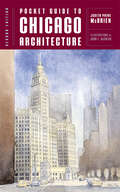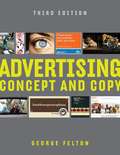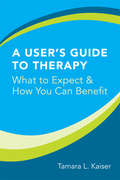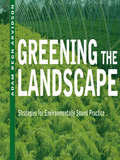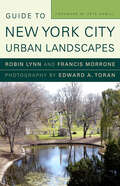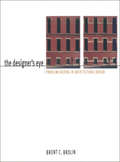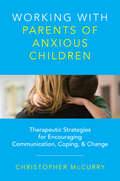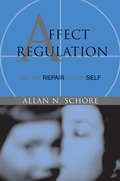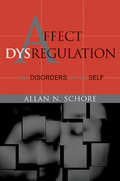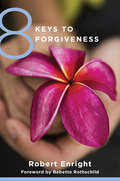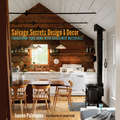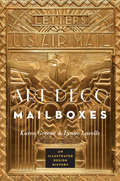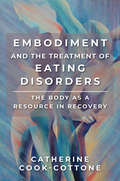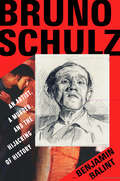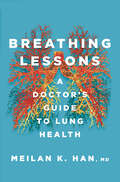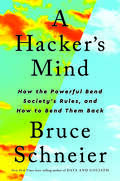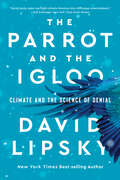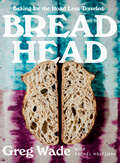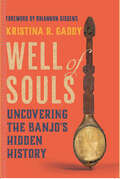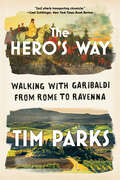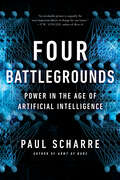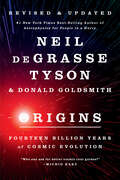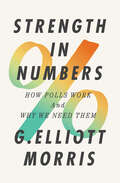- Table View
- List View
Pocket Guide to Chicago Architecture (Norton Pocket Guides #0)
by Judith Paine McBrien“A handy guidebook that profiles a building per page, with a drawing and vital statistics on most of Chicago’s major historic and modern buildings.”—Chicago Tribune Updated and expanded to chart the changing urban landscape of Chicago--as well as to incorporate a section on Chicago’s campus architecture, including works by Rem Koolhaas at the Illinois Institute of Technology and Frank Lloyd Wright at the University of Chicago--the second edition of this popular handbook is a perfect companion for walking tours and an excellent source of background information for exploring the internationally acclaimed architecture of Chicago. Over 100 highlights of downtown Chicago are covered, from Michigan Avenue to the riverfront to the Loop, with accompanying maps, a glossary of architectural terms, and an index of architects and buildings.
Advertising Concept and Copy (3rd Edition)
by George FeltonThis book shows how to find strong selling ideas and how to express them in fresh, memorable, persuasive ways.
A User's Guide to Therapy: What to Expect and How You Can Benefit
by Tamara L. KaiserA guidebook to understanding and getting the most out of therapy. This book is for clients--and for clinicians to recommend to their clients--who want to enhance the process of psychotherapy and get the most out of a therapeutic relationship. Kaiser writes in a friendly, accessible tone, and explains what exactly therapy is and how it works, including the beginning, middle, and ending stages of the therapy process. She elaborates on the dynamics of the relationship between therapist and client, including such issues as power, boundaries, trust, and termination, and describes the four common factors of change: the client, the therapeutic relationship, hope, and technique. Furthermore, she explains the basic aspects of brain development and how psychotherapy physically changes the brain. This book familiarizes potential clients with four major therapeutic approaches--psychodynamic, developmental, cognitive- behavioral, and humanistic--and explains the characteristics of individual, family, and group therapy. Through case studies, Kaiser reveals the healing potential of the therapeutic relationship, including the experience of being deeply understood by and coming to trust a therapist. Kaiser offers much food for thought, as well as compassion, wisdom, encouragement, and practical suggestions for those who choose to take this fascinating and fruitful journey.
Greening the Landscape: Strategies for Environmentally Sound Practice
by Adam Regn ArvidsonA guide to improving the environmental performance of any landscape through the use of green construction and maintenance. Landscapes create obvious environmental benefits but can have unrecognized negative impacts. Adam Regn Arvidson outlines the five primary problem issues--plant pots, vehicle fuel, energy consumption, water/fertilizer use, and green waste--and details a variety of practices, ranging from exceedingly simple ideas to long-term investments, for making the installation and upkeep of landscapes more green. A companion website, GreeningtheLandscapeBook.com, provides readers with additional resources and case studies, arranged by environmental impact and geography.
A Short Bright Flash: Augustin Fresnel and the Birth of the Modern Lighthouse
by Theresa Levitt"Combin[es] matters of biography, science, engineering, technology, art, history, economics and politics seemingly effortlessly and definitely seamlessly. An excellent book and a joy to read."--Henry Petroski, Wall Street Journal Augustin Fresnel (1788-1827) shocked the scientific elite with his unique understanding of the physics of light. The lens he invented was a brilliant feat of engineering that made lighthouses blaze many times brighter, farther, and more efficiently. Battling the establishment, his own poor health, and the limited technology of the time, Fresnel was able to achieve his goal of illuminating the entire French coast. At first, the British sought to outdo the new Fresnel-equipped lighthouses as a matter of national pride. Americans, too, resisted abandoning their primitive lamps, but the superiority of the Fresnel lens could not be denied for long. Soon, from Dunkirk to Saigon, shores were brightened with it. The Fresnel legacy played an important role in geopolitical events, including the American Civil War. No sooner were Fresnel lenses finally installed along U.S. shores than they were drafted: the Union blockaded the Confederate coast; the Confederacy set about thwarting it by dismantling and hiding or destroying the powerful new lights. Levitt's scientific and historical account, rich in anecdote and personality, brings to life the fascinating untold story of Augustin Fresnel and his powerful invention.
Guide to New York City Urban Landscapes
by Robin Lynn Francis MorroneA tour of not-to-be-missed public places—parks, plazas, memorials, streets—that shape the New York experience. The thirty-eight urban gems covered here range from newly created linear spaces along the water’s edge, such as Brooklyn Bridge Park and the East River Waterfront Esplanade, to revitalized squares and circles, such as those at Gansevoort Plaza in the Meatpacking District and Columbus Circle, to repurposed open spaces like the freight tracks, now the High Line, and Concrete Plant Park in the Bronx. Readers can discover midtown atriums, mingle with the crowds in Union Square, travel offshore to nearby Governors Island, and enjoy the vistas of historic Green-Wood Cemetery. Pete Hamill writes in his foreword, “I’ve . . . made a list of new places I must visit while there is time. With any luck at all, I’ll see all of them. I hope you, the reader, can find the time too.” Concise descriptions, helpful maps, and vivid photographs capture the New York urban scene.
The Designer's Eye
by Brent C. BrolinThis imaginative book offers architecture students over a hundred examples of visual problem solving in architectural design. Photographs of actual buildings, paired with digitally manipulated images in 'before and after' comparisons, demonstrate the sorts of real-life situations that architectural design courses rarely teach students how to address, and show how designers can manipulate form and material to achieve desired effects: emphasizing or diminishing building elements, imposing visual order on a façade, or adding grace notes.
Working with Parents of Anxious Children: Therapeutic Strategies for Encouraging Communication, Coping & Change
by Christopher MccurryChanging the parent-child dynamic to improve anxiety symptoms. The topic of anxious children is on the front burner these days, both among parents and mental health professionals, and its only gaining attention as more and more clinicians are presented with anxious kids in their practices. Anxiety symptoms--whether panic, OCD, phobias, social or separation anxiety--are one of the primary reasons parents seek help from a mental health professional for their child. And yet, parents may unintentionally reward or encourage the problem through their own behavior (overprotection on the one hand, punishment on the other, or avoidance of all possible anxiety-provoking situations). This book will tackle that very issue, exploring the critical parent-child "dance" at the center of child development and uncovering how, with the proper knowledge and tools at hand, therapists can guide parents in changing their dynamic so anxious outbursts are reduced and a child's confidence and growth are better supported. A range of techniques that therapists can teach parents will be presented, including how to "change the choreography"--the parent-child dynamic--and how to work with "goodness of fit", or temperamental differences between a parent and a child. Parent management training and parent-child interaction training strategies will also be provided.
Affect Regulation and the Repair of the Self (Norton Series on Interpersonal Neurobiology)
by Allan N. SchoreThis volume (one of two) is the first presentation of Schore's comprehensive theory in book form, as it has developed since 1994. In 1994 Allan Schore published his groundbreaking book, Affect Regulation and the Origin of the Self, in which he integrated a large number of experimental and clinical studies from both the psychological and biological disciplines in order to construct an overarching model of social and emotional development. Since then he has expanded his regulation theory in more than two dozen articles and essays covering multiple disciplines, including neuroscience, psychiatry, psychoanalysis, developmental psychology, attachment, and trauma. Affect Regulation and the Repair of the Self contains chapters on neuropsychoanalysis and developmentally oriented psychotherapy. It is absolutely essential reading for all clinicians, researchers, and general readers interested in normal and abnormal human development.
Affect Dysregulation and Disorders of the Self (Norton Series on Interpersonal Neurobiology)
by Allan N. SchoreThis volume (one of two) is the first presentation of Schore's comprehensive theory in book form, as it has developed since 1994. In 1994 Allan Schore published his groundbreaking book, Affect Regulation and the Origin of the Self, in which he integrated a large number of experimental and clinical studies from both the psychological and biological disciplines in order to construct an overarching model of social and emotional development. Since then he has expanded his regulation theory in more than two dozen articles and essays covering multiple disciplines, including neuroscience, psychiatry, psychoanalysis, developmental psychology, attachment, and trauma. Affect Dysregulation and Disorders of the Self contains writings on developmental affective neuroscience and developmental neuropsychiatry. It is absolutely essential reading for all clinicians, researchers, and general readers interested in normal and abnormal human development.
8 Keys to Forgiveness (8 Keys to Mental Health)
by Robert Enright Babette RothschildA practical guide by the man Time magazine has called “the forgiveness trailblazer.” While it may seem like a simple enough act, forgiveness is a difficult, delicate process which, if executed correctly, can be profoundly moving and a deep learning experience. Whatever the scenario may be—whether you need to make peace with a certain situation, with a loved one or friend, or with a total stranger—the process of forgiveness is an art and a science, and this hands-on guide walks readers through it in 8 key steps. How can we become forgivingly “fit”? How can we identify the source of our pain and inner turmoil? How can we find meaning in what we have suffered, or learn to forgive ourselves? What should we do when forgiveness feels like a particularly tall order? All these questions and more are answered in this practical book, leading us to become more tolerant, compassionate, and hopeful human beings.
Salvage Secrets Design & Decor: Transform Your Home with Reclaimed Materials
by Susan Teare Joanne PalmisanoA visually sumptuous idea book, showcasing an eclectic array of interior design possibilities using salvaged goods. Following up on her celebrated first Salvage Secrets book, which Fine Homebuilding called "An invaluable first step in the salvage-for-design journey," here salvage design guru Joanne Palmisano takes readers further, exploring a wealth of smaller-scale interior design and decor concepts. Bottle caps turned into a kitchen backsplash, old bed springs reinvented as candle holders, and a recycled shipping container-turned-guesthouse are just a few examples of the innovative repurposing of second-hand items that readers will discover. From retro and modern to classic, "cottage," and urban chic, Palmisano takes readers on a sumptuous visual journey featuring unique salvage ideas in an eclectic array of styles, for every room in the house--kitchens and dining rooms, bedrooms and bathrooms, living rooms and dens, and entryways and outdoor areas. The journey continues with a sampling of cutting-edge retail spaces, hotels, cafes, and boutiques across the country that incorporate salvage into their designs, such as Industrie Denim in San Francisco, Stowe Mountain Lodge in Stowe, Vermont, and Rejuvenation in Portland. Profiles of thirteen "salvage success stories" are also included, showcasing the imaginative designs of creative homeowners. And lastly, fourteen easy, do-it-yourself projects are included at the back of the book (with step-by-step instructions), not to mention a comprehensive "Where to Find Salvage" resource section. Packed with over 350 color photos, Salvage Secrets Design & Decor offers a trove of salvage ideas to inspire, proving that you need look no further than your local rebuild center, architectural salvage shop, or flea market to transform your living space.
Art Deco Mailboxes: An Illustrated Design History
by Karen Greene Lynne LavelleA great gift book for lovers of unsung urban decorative art and unique architectural details. Mailboxes and their chutes were once as essential to the operation of any major hotel, office, civic, or residential building as the front door. In time they developed a decorative role, in a range of styles and materials, and as American art deco architecture flourished in the 1920s and 1930s they became focal points in landmark buildings and public spaces: the GE Building, Grand Central Terminal, the Woolworth Building, 29 Broadway, the St. Regis Hotel, York & Sawyer’s Salmon Tower, the Waldorf Astoria, and many more. While many mailboxes have been removed, forgotten, disused, or painted over (and occasionally repurposed), others are still in use, are polished daily, and hold a place of pride in lobbies throughout the country. A full-color photographic survey of beautiful early mailboxes, highlighting those of the grand art deco period, together with a brief history of the innovative mailbox-and-chute system patented in 1883 by James Cutler of Rochester, New York, Art Deco Mailboxes features dozens of the best examples of this beloved, dynamic design’s realization in the mailboxes of New York City as well as Chicago, Philadelphia, Indianapolis, Cincinnati, and beyond.
Embodiment and the Treatment of Eating Disorders: The Body As A Resource In Recovery
by Catherine Cook-CottoneTools for the clinician to help clients turn their bodies into resources for healing from eating disorders. Embodiment refers to the lived attunement of the inner and outer experience of self. Cognitions are aligned with the sensing and feeling body. Further, in an attuned experience of self, positive embodiment is maintained by internally focused tools, such as self-care practices that support physiological health, emotional well-being, and effective cognitive functioning. For those who suffer from eating disorders, this is not the case; in fact, the opposite is true. Disordered thinking, an unattuned sense of self, and negative cognitions abound. Turning this thinking around is key to client resilience and treatment successes. Catherine Cook-Cottone provides tools for clinicians working with clients to restore their healthy selves and use their bodies as a positive resource for healing and long-term health. The book goes beyond traditional treatments to talk about mindful self-care, mindful eating, yoga, and other practices designed to support self-regulation.
How to Make a Killing: Blood, Death and Dollars in American Medicine
by Tom MuellerHow did a lifesaving medical breakthrough become a for-profit enterprise that threatens many of the people it’s meant to save? Six decades ago, visionary doctors achieved the impossible: the humble kidney, acknowledged since ancient times to be as essential to life as the heart, became the first human organ to be successfully replaced with a machine. Yet huge dialysis corporations, ambitious doctor-entrepreneurs and Beltway lobbyists soon turned this medical miracle into an early experiment in for-profit medicine—and one of the nation’s worst healthcare catastrophes. With powerful insight and on-the-ground reporting, New York Times best-selling author Tom Mueller introduces an unforgettable cast of characters. Heroic patients, including a Hollywood stuntman and body double, risk their lives to blow the whistle on how they’ve been mistreated. An unpaid activist living in a south Georgia trailer park fights to save patients from involuntary discharge from their lifesaving care. Industry insiders put their careers on the line to speak out about the endemic wrongs and pervasive inequality they’ve witnessed—and about dialysis executives who dress as musketeers and Star Wars characters to exhort their employees to more aggressive profit-seeking. Mueller evokes the scientific ingenuity and optimism of the 1950s and 1960s, when the burgeoning field of organ transplant and early dialysis machines offered long-awaited hope for lifesaving care. That is, until a New York salesman had himself dialyzed on the floor of the House, and Congress made renal disease the only “Medicare for All” condition—opening the financial floodgates for Big Dialysis. Of the thousands caught in a web of corporate greed, a disproportionate number are Black and Latino, highlighting the stark racial divides already endemic to American medicine. How to Make a Killing reveals dialysis as a microcosm of American medicine and poses a vital challenge: find a way to fix dialysis, and we’ll have a fighting chance of fixing our country’s dysfunctional healthcare system as a whole, restoring patients, not profits, as its true purpose.
Bruno Schulz: An Artist, a Murder, and the Hijacking of History
by Benjamin BalintA fresh portrait of the Polish-Jewish writer and artist, and a gripping account of the secret operation to rescue his last artworks. The twentieth-century artist Bruno Schulz was born an Austrian, lived as a Pole, and died a Jew. First a citizen of the Habsburg monarchy, he would, without moving, become the subject of the West Ukrainian People’s Republic, the Second Polish Republic, the USSR, and, finally, the Third Reich. Yet to use his own metaphor, Schulz remained throughout a citizen of the Republic of Dreams. He was a master of twentieth-century imaginative fiction who mapped the anxious perplexities of his time; Isaac Bashevis Singer called him “one of the most remarkable writers who ever lived.” Schulz was also a talented illustrator and graphic artist whose masochistic drawings would catch the eye of a sadistic Nazi officer. Schulz’s art became the currency in which he bought life. Drawing on extensive new reporting and archival research, Benjamin Balint chases the inventive murals Schulz painted on the walls of an SS villa—the last traces of his vanished world—into multiple dimensions of the artist’s life and afterlife. Sixty years after Schulz was murdered, those murals were miraculously rediscovered, only to be secretly smuggled by Israeli agents to Jerusalem. The ensuing international furor summoned broader perplexities, not just about who has the right to curate orphaned artworks and to construe their meanings, but about who can claim to stand guard over the legacy of Jews killed in the Nazi slaughter. By re-creating the artist’s milieu at a crossroads not just of Jewish and Polish culture but of art, sex, and violence, Bruno Schulz itself stands as an act of belated restitution, offering a kaleidoscopic portrait of a life with all its paradoxes and curtailed possibilities.
Breathing Lessons: A Doctor's Guide To Lung Health
by MeiLan K. HanAn authoritative, accessible guide to how our lungs work and how to protect them. Most of us pay little attention to the workings of our lungs, but the COVID-19 pandemic has sparked interest in their functioning and fear about the risks they face. Dr. MeiLan K. Han, a leading pulmonologist and a national spokesperson for the American Lung Association, takes readers on a fascinating tour of this most vital organ. Han explains the wonder of breathing and reveals how the lungs serve as the body’s first line of defense. She provides a timely overview of the latest scientific thinking about the leading respiratory risks—including indoor and outdoor pollution, smoking and vaping, wildfire smoke, and viruses like SARS-CoV-2—and offers a practical guide to keeping lungs healthy. And with authority as both practitioner and medical researcher, she argues powerfully for a social policy that makes a priority of preserving lung health nationwide.
A Hacker's Mind: How the Powerful Bend Society's Rules, and How to Bend them Back
by Bruce SchneierIt’s not just computers—hacking is everywhere. Legendary cybersecurity expert and New York Times best-selling author Bruce Schneier reveals how using a hacker’s mindset can change how you think about your life and the world. A hack is any means of subverting a system’s rules in unintended ways. The tax code isn’t computer code, but a series of complex formulas. It has vulnerabilities; we call them “loopholes.” We call exploits “tax avoidance strategies.” And there is an entire industry of “black hat” hackers intent on finding exploitable loopholes in the tax code. We call them accountants and tax attorneys. In A Hacker’s Mind, Bruce Schneier takes hacking out of the world of computing and uses it to analyze the systems that underpin our society: from tax laws to financial markets to politics. He reveals an array of powerful actors whose hacks bend our economic, political, and legal systems to their advantage, at the expense of everyone else. Once you learn how to notice hacks, you’ll start seeing them everywhere—and you’ll never look at the world the same way again. Almost all systems have loopholes, and this is by design. Because if you can take advantage of them, the rules no longer apply to you. Unchecked, these hacks threaten to upend our financial markets, weaken our democracy, and even affect the way we think. And when artificial intelligence starts thinking like a hacker—at inhuman speed and scale—the results could be catastrophic. But for those who would don the “white hat,” we can understand the hacking mindset and rebuild our economic, political, and legal systems to counter those who would exploit our society. And we can harness artificial intelligence to improve existing systems, predict and defend against hacks, and realize a more equitable world.
The Parrot and the Igloo: Climate And The Science Of Denial
by David LipskyA New York Times Editors’ Choice Named a Best Book of the Year in The New Yorker, Publishers Weekly, Chicago Tribune, and EcoLit Books A USA Today Must-Read Summer Book "David Lipsky spins top-flight climate literature into cliffhanger entertainment." —Zoë Schlanger, New York Times Book Review The New York Times best-selling author explores how “anti-science” became so virulent in American life—through a history of climate denial and its consequences. In 1956, the New York Times prophesied that once global warming really kicked in, we could see parrots in the Antarctic. In 2010, when science deniers had control of the climate story, Senator James Inhofe and his family built an igloo on the Washington Mall and plunked a sign on top: AL GORE'S NEW HOME: HONK IF YOU LOVE CLIMATE CHANGE. In The Parrot and the Igloo, best-selling author David Lipsky tells the astonishing story of how we moved from one extreme (the correct one) to the other. With narrative sweep and a superb eye for character, Lipsky unfolds the dramatic narrative of the long, strange march of climate science. The story begins with a tale of three inventors—Thomas Edison, George Westinghouse, and Nikola Tesla—who made our technological world, not knowing what they had set into motion. Then there are the scientists who sounded the alarm once they identified carbon dioxide as the culprit of our warming planet. And we meet the hucksters, zealots, and crackpots who lied about that science and misled the public in ever more outrageous ways. Lipsky masterfully traces the evolution of climate denial, exposing how it grew out of early efforts to build a network of untruth about products like aspirin and cigarettes. Featuring an indelible cast of heroes and villains, mavericks and swindlers, The Parrot and the Igloo delivers a real-life tragicomedy—one that captures the extraordinary dance of science, money, and the American character.
Bread Head: Baking for the Road Less Traveled
by Greg Wade Rachel HoltzmanA groovy master class in healthy, sustainable, naturally delicious breads from a star of the new bread renaissance. Greg Wade is an expert in the out-of-this-world tastes and textures of long-fermented, hand-shaped breads. The recipient of the James Beard Award for Outstanding Baker (2019) is committed to spreading the love for local, organic flours and long-fermented sourdough loaves far and wide as he kneads, stretches, and proofs his signature loaves each day at Publican Quality Bread in Chicago. Bread Head is his guide to making all your favorite professional-level breads, cakes, and pastries at home. Bread Head takes home cooks through foundational recipes like Farmhouse Sourdough and Marbled Rye down a winding road to unexpected and delicious bakes. Sorghum and Rosemary Ciabatta, Wheat Neapolitan Pizza Dough, Ethiopian Injera, Indian Parathas, and Georgian Khachapuri will become welcome new staples in your culinary repertoire. For those with a sweeter tooth, try Greg’s Buckwheat Brownies, Wheat Brioche, and Cornmeal Whoopie Pies. Through accessible, teachable recipes that include baker’s percentages and capture the importance of hydration and hand-shaping, Greg will improve your baking know-how, confidence, and zeal in the kitchen. The science and technique are all here: Go forth and explore the infinite universes of delights in each of Greg Wade’s inventive recipes.
Well of Souls: Uncovering The Banjo's Hidden History
by Kristina R. GaddyOne of The New Yorker’s Best Books of the Year Named one of the Most Memorable Music Books of the Year by No Depression: The Journal of Roots Music “Compelling.… [R]eveals [an instrument] intimately rooted in the African diaspora and capable of expressing flights of sorrow and joy.” —David Yezzi, Wall Street Journal An illuminating history of the banjo, revealing its origins at the crossroads of slavery, religion, and music. In an extraordinary story unfolding across two hundred years, Kristina Gaddy uncovers the banjo’s key role in Black spirituality, ritual, and rebellion. Through meticulous research in diaries, letters, archives, and art, she traces the banjo’s beginnings from the seventeenth century, when enslaved people of African descent created it from gourds or calabashes and wood. Gaddy shows how the enslaved carried this unique instrument as they were transported and sold by slaveowners throughout the Americas, to Suriname, the Caribbean, and the colonies that became U.S. states, including Louisiana, South Carolina, Maryland, and New York. African Americans came together at rituals where the banjo played an essential part. White governments, rightfully afraid that the gatherings could instigate revolt, outlawed them without success. In the mid-nineteenth century, Blackface minstrels appropriated the instrument for their bands, spawning a craze. Eventually the banjo became part of jazz, bluegrass, and country, its deepest history forgotten.
The Hero's Way: Walking With Garibaldi From Rome To Ravenna
by Tim ParksThe acclaimed author of Italian Ways returns with an exploration into Italy’s past and present—following in the footsteps of Garibaldi’s famed 250-mile journey across the Apennines. In the summer of 1849, Giuseppe Garibaldi, Italy’s legendary revolutionary, was finally forced to abandon his defense of Rome. He and his men had held the besieged city for four long months, but now it was clear that only surrender would prevent slaughter and destruction at the hands of a huge French army. Against all odds, Garibaldi was determined to turn defeat into moral victory. On the evening of July 2, riding alongside his pregnant wife, Anita, he led 4,000 hastily assembled men to continue the struggle for national independence elsewhere. Hounded by both French and Austrian armies, the garibaldini marched hundreds of miles across the Appenines, Italy’s mountainous spine, and after two months of skirmishes and adventures arrived in Ravenna with just 250 survivors. Best-selling author Tim Parks, together with his partner Eleonora, set out in the blazing summer of 2019 to follow Garibaldi and Anita’s arduous journey through the heart of Italy. In The Hero’s Way he delivers a superb travelogue that captures Garibaldi’s determination, creativity, reckless courage, and profound belief. And he provides a fascinating portrait of Italy then and now, filled with unforgettable observations of Italian life and landscape, politics, and people.
Four Battlegrounds: Power In The Age Of Artificial Intelligence
by Paul ScharreAn NPR 2023 "Books We Love" Pick One of the Next Big Idea Club's Must-Read Books "An invaluable primer to arguably the most important driver of change for our future." —P. W. Singer, author of Burn-In An award-winning defense expert tells the story of today’s great power rivalry—the struggle to control artificial intelligence. A new industrial revolution has begun. Like mechanization or electricity before it, artificial intelligence will touch every aspect of our lives—and cause profound disruptions in the balance of global power, especially among the AI superpowers: China, the United States, and Europe. Autonomous weapons expert Paul Scharre takes readers inside the fierce competition to develop and implement this game-changing technology and dominate the future. Four Battlegrounds argues that four key elements define this struggle: data, computing power, talent, and institutions. Data is a vital resource like coal or oil, but it must be collected and refined. Advanced computer chips are the essence of computing power—control over chip supply chains grants leverage over rivals. Talent is about people: which country attracts the best researchers and most advanced technology companies? The fourth “battlefield” is maybe the most critical: the ultimate global leader in AI will have institutions that effectively incorporate AI into their economy, society, and especially their military. Scharre’s account surges with futuristic technology. He explores the ways AI systems are already discovering new strategies via millions of war-game simulations, developing combat tactics better than any human, tracking billions of people using biometrics, and subtly controlling information with secret algorithms. He visits China’s “National Team” of leading AI companies to show the chilling synergy between China’s government, private sector, and surveillance state. He interviews Pentagon leadership and tours U.S. Defense Department offices in Silicon Valley, revealing deep tensions between the military and tech giants who control data, chips, and talent. Yet he concludes that those tensions, inherent to our democratic system, create resilience and resistance to autocracy in the face of overwhelmingly powerful technology. Engaging and direct, Four Battlegrounds offers a vivid picture of how AI is transforming warfare, global security, and the future of human freedom—and what it will take for democracies to remain at the forefront of the world order.
Origins: Fourteen Billion Years Of Cosmic Evolution
by Donald Goldsmith Neil deGrasse Tyson“Who can ask for better cosmic tour guides?” —Michio Kaku Our true origins are not only human, or even terrestrial, but in fact cosmic. Drawing on recent scientific breakthroughs and cross-pollination among geology, biology, astrophysics, and cosmology, Origins illuminates the soul-stirring leaps in our understanding of the cosmos. This revised and updated edition features such startling discoveries as the now more than 5,000 detected exoplanets that promise to reveal exciting possibilities for life in the cosmos, and data from a new generation of ground-based and spaceborne observatories that have fundamentally changed what we know about the expanding universe?and maybe even the laws of physics themselves. From the first image of a galaxy’s birth to tantalizing evidence of water not only on Mars but also on the asteroid Ceres, as well as on moons of Jupiter and Saturn, coauthors Neil deGrasse Tyson and Donald Goldsmith conduct an exhilarating tour of the cosmos with clarity and exuberance.
Strength in Numbers: How Polls Work and Why We Need Them
by G. Elliott MorrisAn insightful exploration of political polling and a bold defense of its crucial role in a modern democracy. Public opinion polling is the ultimate democratic process; it gives every person an equal voice in letting elected leaders know what they need and want. But in the eyes of the public, polls today are tarnished. Recent election forecasts have routinely missed the mark and media coverage of polls has focused solely on their ability to predict winners and losers. Polls deserve better. In Strength in Numbers, data journalist G. Elliott Morris argues that the larger purpose of political polls is to improve democracy, not just predict elections. Whether used by interest groups, the press, or politicians, polling serves as a pipeline from the governed to the government, giving citizens influence they would otherwise lack. No one who believes in democracy can afford to give up on polls; they should commit, instead, to understanding them better. In a vibrant history of polling, Morris takes readers from the first semblance of data-gathering in the ancient world through to the development of modern-day scientific polling. He explains how the internet and “big data” have solved many challenges in polling—and created others. He covers the rise of polling aggregation and methods of election forecasting, reveals how data can be distorted and misrepresented, and demystifies the real uncertainty of polling. Candidly acknowledging where polls have gone wrong in the past, Morris charts a path for the industry’s future where it can truly work for the people. Persuasively argued and deeply researched, Strength in Numbers is an essential guide to understanding and embracing one of the most important and overlooked democratic institutions in the United States.
